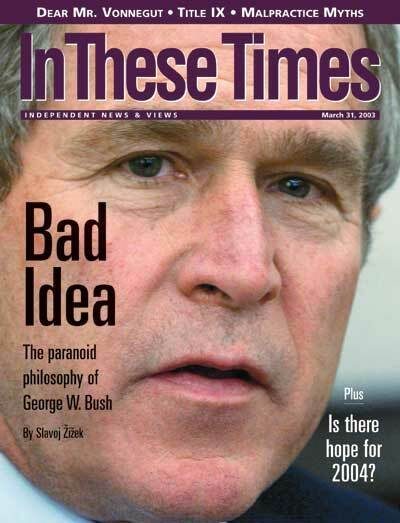
Just when it seemed the democratic promise of the Internet would never come to pass, a glimmer of hope has arrived.
On February 26, the lefty online organizers known as MoveOn orchestrated their latest coup, signing up people all over the country to place a phone call to their senator’s offices as part of a massive “virtual march” on Washington. Every Senator and the White House switchboard got a phone call, every minute of the work day, from Americans opposed to war in Iraq. Final numbers are impossible to verify, but according to news reports as In These Times went to press, at least 140,000 calls were placed by day’s end.
Actions like these have made MoveOn one of the prime movers in the current movement against the war. And with at least 700,000 members signed up to date, MoveOn may be much more than a glimmer.
So how does an organization founded in late 1998, with an employee roster of only five—plus two full-time volunteers—enlist 140,000 average Americans to each make a phone call?
Simple, says MoveOn Executive Director Peter Schurman—you just ask them. “There’s no trick,” says Schurman on how his group drums up participation. “The trick is giving people an opportunity to have their voices heard, especially when there is a major disconnect … between the clear consensus of public opinion and the direction that policy-makers are headed.”
One recent instance of such a disconnect was the extended impeachment proceedings against former President Clinton. MoveOn was one product of that tragi-comedy, a classic example of private frustration turned into public action. “Congress was wasting all its time on impeachment,” Schurman recalls. “The American people weren’t too happy about it.”
Among the unhappy were Joan Blades and Wes Boyd, two liberal Silicon Valley entrepreneurs who had recently sold their software company, Berkeley Systems. Blades and Boyd, Schurman says, “sent an e-mail to 100 of their friends saying Congress should censure the President and move on.”
In an age where many an inbox groans under the weight of infinite petitions—and many of us have given up on changing the world with a click—Boyd and Blades did it right. They created a new kind of petition, a simple online submission form, eliminating the uncertainty and logistical nightmare of the “please forward endlessly” version. And it worked. Their original e-mail to a hundred friends quickly generated half a million sign-ups, and MoveOn was born.
After the impeachment, the new organization turned its attention to Congress. While continuing to build MoveOn as an online organizer, they formed a separate entity, the MoveOn Political Action Committee, to raise money for candidates.
In fall of 2002, the PAC was an important contributor to Sen. Paul Wellstone’s campaign for re-election in Minnesota before his death less than two weeks before the election. This success, Schurman says, shows that certain progressive views—especially on foreign policy—may be far more popular with the American public than common wisdom reflects. “Senator Wellstone was extremely courageous in speaking out on the war in Iraq,” Schurman explains, “and benefited handsomely from it in terms of financial awards from our members.”
MoveOn’s model—soliciting small donations averaging just $35—allows a wide range of people to participate. The other advantage is immediacy: In just 48 hours of fundraising for former Vice President Walter Mondale, who replaced Wellstone on the ticket after his death, the MoveOn PAC says it raised $600,000.
Schurman suggests that the MoveOn PAC, along with other stalwarts of online fundraising like Emily’s List, are “really the model for campaign funding in the post campaign finance reform world.”
MoveOn has taken a very similar approach to raising money for its anti-war campaign. Of late, MoveOn has focused on its “Let the Inspections Work” anti-war campaign, of which the virtual march is just a part. An appeal to members to support a full-page ad in the New York Times in January was so successful—raising over $400,000, again in increments averaging just $35—that MoveOn was able to create an entire advertising campaign, including a television ad that ran in 13 cities.
The group’s broader mission is simply civic engagement, explains Schurman. “We are putting democracy in action. We are making it possible for everyday people … to participate meaningfully in the civic process in a way that’s comfortable for them and effective.”
He proudly points out that the people giving to these campaigns, and the people taking part in events like the virtual march, aren’t necessarily those often associated with protest and dissent. “Our typical member is not your typical protester,” Schurman says. “It’s your typical mainstream American. Fathers and mothers, plumbers, teachers, grocers, whatever. This is America. These are Americans. These are voters.”
On February 26, the lefty online organizers known as MoveOn orchestrated their latest coup, signing up people all over the country to place a phone call to their senator’s offices as part of a massive “virtual march” on Washington. Every Senator and the White House switchboard got a phone call, every minute of the work day, from Americans opposed to war in Iraq. Final numbers are impossible to verify, but according to news reports as In These Times went to press, at least 140,000 calls were placed by day’s end.
Actions like these have made MoveOn one of the prime movers in the current movement against the war. And with at least 700,000 members signed up to date, MoveOn may be much more than a glimmer.
So how does an organization founded in late 1998, with an employee roster of only five—plus two full-time volunteers—enlist 140,000 average Americans to each make a phone call?
Simple, says MoveOn Executive Director Peter Schurman—you just ask them. “There’s no trick,” says Schurman on how his group drums up participation. “The trick is giving people an opportunity to have their voices heard, especially when there is a major disconnect … between the clear consensus of public opinion and the direction that policy-makers are headed.”
One recent instance of such a disconnect was the extended impeachment proceedings against former President Clinton. MoveOn was one product of that tragi-comedy, a classic example of private frustration turned into public action. “Congress was wasting all its time on impeachment,” Schurman recalls. “The American people weren’t too happy about it.”
Among the unhappy were Joan Blades and Wes Boyd, two liberal Silicon Valley entrepreneurs who had recently sold their software company, Berkeley Systems. Blades and Boyd, Schurman says, “sent an e-mail to 100 of their friends saying Congress should censure the President and move on.”
In an age where many an inbox groans under the weight of infinite petitions—and many of us have given up on changing the world with a click—Boyd and Blades did it right. They created a new kind of petition, a simple online submission form, eliminating the uncertainty and logistical nightmare of the “please forward endlessly” version. And it worked. Their original e-mail to a hundred friends quickly generated half a million sign-ups, and MoveOn was born.
After the impeachment, the new organization turned its attention to Congress. While continuing to build MoveOn as an online organizer, they formed a separate entity, the MoveOn Political Action Committee, to raise money for candidates.
In fall of 2002, the PAC was an important contributor to Sen. Paul Wellstone’s campaign for re-election in Minnesota before his death less than two weeks before the election. This success, Schurman says, shows that certain progressive views—especially on foreign policy—may be far more popular with the American public than common wisdom reflects. “Senator Wellstone was extremely courageous in speaking out on the war in Iraq,” Schurman explains, “and benefited handsomely from it in terms of financial awards from our members.”
MoveOn’s model—soliciting small donations averaging just $35—allows a wide range of people to participate. The other advantage is immediacy: In just 48 hours of fundraising for former Vice President Walter Mondale, who replaced Wellstone on the ticket after his death, the MoveOn PAC says it raised $600,000.
Schurman suggests that the MoveOn PAC, along with other stalwarts of online fundraising like Emily’s List, are “really the model for campaign funding in the post campaign finance reform world.”
MoveOn has taken a very similar approach to raising money for its anti-war campaign. Of late, MoveOn has focused on its “Let the Inspections Work” anti-war campaign, of which the virtual march is just a part. An appeal to members to support a full-page ad in the New York Times in January was so successful—raising over $400,000, again in increments averaging just $35—that MoveOn was able to create an entire advertising campaign, including a television ad that ran in 13 cities.
The group’s broader mission is simply civic engagement, explains Schurman. “We are putting democracy in action. We are making it possible for everyday people … to participate meaningfully in the civic process in a way that’s comfortable for them and effective.”
He proudly points out that the people giving to these campaigns, and the people taking part in events like the virtual march, aren’t necessarily those often associated with protest and dissent. “Our typical member is not your typical protester,” Schurman says. “It’s your typical mainstream American. Fathers and mothers, plumbers, teachers, grocers, whatever. This is America. These are Americans. These are voters.”
Ben Winters is a journalist, arts critic, and playwright living in Brooklyn.






